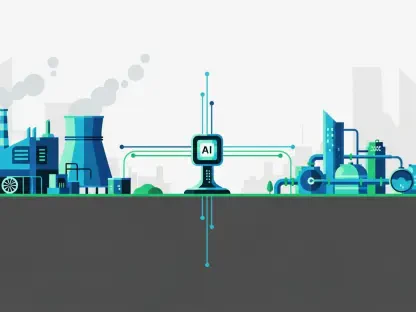As the digital age accelerates, industries worldwide are witnessing significant transformations in their operational processes, with manufacturing at the forefront of this evolution. The infusion of big data into manufacturing metrology is redefining the landscape, moving away from traditional methods to embrace innovative smart manufacturing techniques. This revolution is not only enhancing efficiency and quality but also opening new avenues for predictive analytics and process optimization. Understanding these changes provides insight into how industries are adapting and thriving in this new era of interconnectedness and data-driven decision-making.
The Shift from Traditional to Contemporary Approaches
The Limitations of Traditional Metrology
In the past, manufacturing metrology primarily hinged on labor-intensive methodologies that revolved around tools like coordinate measuring machines (CMMs) and manual documentation. These conventional strategies, although effective in providing precise measurements, often lacked the capability to predict or prevent defects, acting instead as reactive measures. Companies heavily relied on these techniques to ensure product quality, but they were confined to providing momentary insights without much room for proactive process improvements. Consequently, the limitations of these traditional approaches often manifested in inefficient processes and missed opportunities for early problem detection, leading to increased costs and delays.
Furthermore, the static nature of these data-collection methods did not provide manufacturers with real-time information crucial for making timely decisions. By the time issues were identified and rectified, significant resources were often expended. This limitation resulted in a fragmented view of the production ecosystem, which hindered the ability to foresee and mitigate future challenges. As industries seek to address these challenges, the transition to more dynamic, integrated metrology solutions becomes imperative, paving the way for big data and smart manufacturing technologies.
The Role of IoT and Big Data
The emergence of the Internet of Things (IoT) and the extensive capabilities of big data analytics have fundamentally transformed manufacturing metrology. Unlike traditional techniques, modern solutions leverage a seamless flow of information from various sources such as sensors on manufacturing machines and environmental data. The integration of big data into manufacturing processes facilitates the continuous gathering and analysis of information, offering a comprehensive understanding of the production environment. This real-time data enables manufacturers to make informed decisions rapidly, resulting in enhanced operational efficiency.
Furthermore, big data is characterized by its five key attributes: volume, velocity, variety, veracity, and value. The massive volume of data generated from diverse sources across the production lifecycle provides a vast landscape for analysis. Coupled with high velocity, this data supports immediate insight generation necessary for rapid adjustments in the manufacturing process. The variety of formats handled, from structured CMM readings to unstructured data such as images, means that an extensive range of information can be processed. Ensuring veracity guarantees data integrity, while the value extracted from these insights translates into improved efficiency and quality.
Smart Manufacturing: An Integrated Approach
Real-Time Monitoring and Predictive Maintenance
One of the most significant transformations brought about by big data in manufacturing is the advent of real-time monitoring systems. These systems enable the continuous tracking of quality parameters across production lines, allowing for instantaneous detection and correction of deviations. By identifying anomalies as they occur, manufacturers can prevent the production of defective parts, significantly reducing waste and associated costs. This ability to monitor operations in real-time forms the backbone of modern smart manufacturing, enabling more agile and responsive production processes that can swiftly adapt to changing conditions.
Predictive maintenance is another area where big data analytics provide substantial value. By analyzing both historical and real-time machine data, manufacturing systems can predict potential failures and schedule maintenance proactively. This approach minimizes unplanned downtime and enhances resource allocation efficiency, ensuring that manufacturing remains uninterrupted while optimizing maintenance schedules. The prediction of machine health and the implementation of preventative measures result in tangible cost savings and extended equipment life, further solidifying the role of big data in transformative manufacturing practices.
Process Optimization and Digital Twins
Beyond immediate operational improvements, big data analytics enable more profound process optimization by uncovering patterns and correlations within extensive datasets. These insights facilitate refinements in areas such as machine settings, material flow, and environmental conditions, contributing to more effective manufacturing processes. The data-driven approach allows for adjustments that enhance productivity while maintaining stringent quality standards, underscoring the strategic role of analytics in manufacturing evolution.
Digital twins, which are virtual replicas of physical assets, represent another innovative application of big data in manufacturing. These models allow for simulated testing and refinement of processes in a controlled digital environment, providing invaluable insights without disrupting actual production. Manufacturers can test various scenarios to determine the best course of action, enabling both enhanced process efficiency and reduced risk of operational errors. As a powerful tool, digital twins bridge the gap between physical and digital realms, driving forward more robust and insightful manufacturing strategies.
Challenges and Opportunities in Data Integration
Ensuring Data Interoperability and Security
While the integration of big data into manufacturing offers numerous benefits, it also presents several challenges that must be addressed to achieve seamless operations. One critical aspect is ensuring data interoperability, which involves the integration of diverse data sources and systems. Establishing standardized communication protocols and data models is essential for different platforms to work harmoniously. Only through a unified approach can manufacturers leverage the full potential of their data assets for more cohesive operation and decision-making.
Security is another paramount consideration in the landscape of smart manufacturing. With vast amounts of sensitive data generated, robust security measures are necessary to protect against breaches and ensure data privacy. Implementing advanced cybersecurity frameworks and regular audits helps mitigate risks and safeguard critical manufacturing information. This secure environment not only protects data but also instills trust in data-driven processes, encouraging further adoption and integration of these advanced technologies in manufacturing practices.
Overcoming Skills and Infrastructure Challenges
The successful implementation of big data analytics in manufacturing is contingent upon possessing a workforce skilled in data analysis and domain-specific knowledge. The complexity of interpreting vast datasets to extract actionable insights requires professionals adept in both the nuances of data analytics and the specifics of the manufacturing landscape. Training and development programs must evolve to equip individuals with the necessary skills, fostering a new generation of data-literate workers capable of driving the smart manufacturing revolution forward.
Alongside the need for expertise, the financial implications of investing in infrastructure for data collection, processing, and analysis pose another challenge. High-capacity storage systems, advanced computing platforms, and robust network infrastructure are fundamental requirements for handling big data operations effectively. Manufacturers must weigh the upfront costs against the potential long-term benefits, realizing that these investments are crucial for maintaining competitiveness in a rapidly evolving industry landscape.
Looking Ahead: Embracing a New Era in Manufacturing
As the pace of the digital age accelerates, industries worldwide are experiencing profound changes, particularly in their operation and production processes. Manufacturing stands at the forefront of this transformative wave, dramatically altering its practices through the integration of big data. This shift is reshaping the field of manufacturing metrology, pushing it beyond traditional techniques towards embracing modern smart manufacturing. By harnessing innovative data analytics and process optimization tools, industries are not only boosting efficiency and quality but are also venturing into new opportunities in the realm of predictive analytics. These advancements bring fresh insights into how sectors are adapting, thriving, and reshaping themselves in this era, marked by interconnectedness and data-driven strategies. Understanding these shifts is essential for grasping the ongoing evolution in manufacturing, demonstrating how big data and modern technology play a crucial role in sustaining competitiveness and fostering growth in our increasingly data-centric world.









